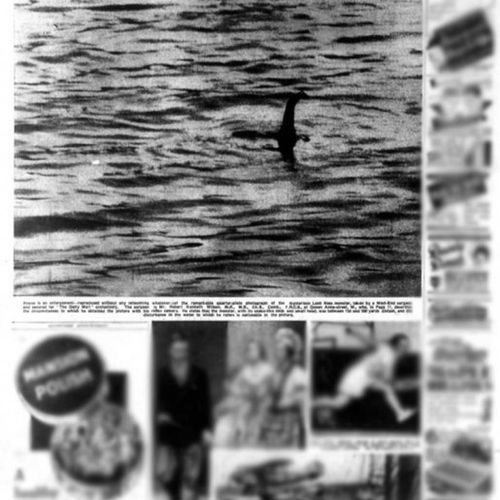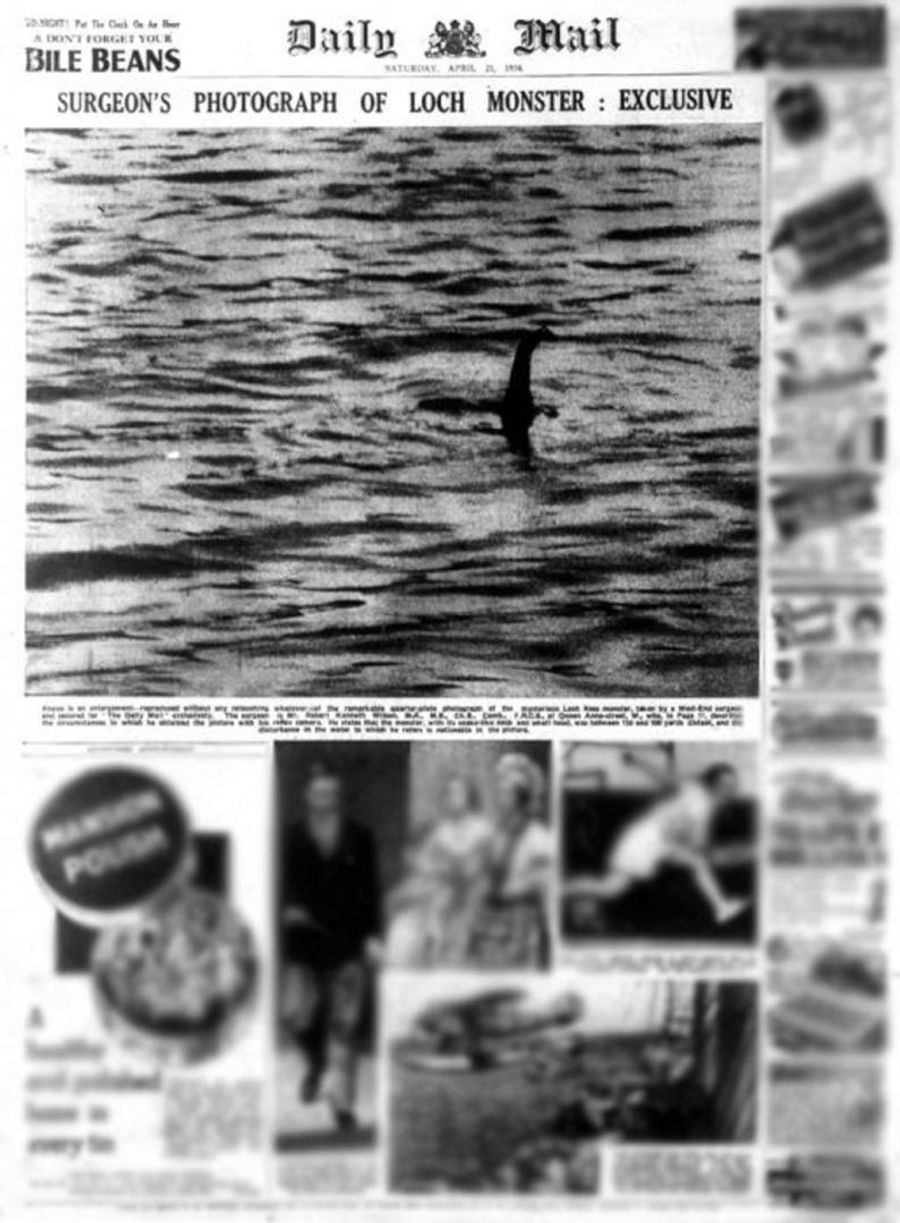
| Added | Thu, 15/02/2018 |
| Источники | |
| Феномены | |
| Версии |
The Loch ness monster (Loch Ness Monster, Nessie or Latin Nessitera rhombopteryx) is a large monster that lives in the Scottish lake Loch ness, according to a widely known urban legend.
The legend of the Loch ness monster appeared almost two millennia ago, and later reflected in medieval folklore and from there came to the newspaper.
According to legend, the first about the mysterious creature in the Scottish lake told the Roman legionaries. Later, in the 18th century, during the restoration of the military roads of General Wade on the South shore of the lake was carried out blasting work, during which workers saw two huge monsters, which scared the sound of the explosion. During the 19th century the monster was described as an enormous Salamander, and in 1880 he was accused of sinking a small sailboat with people.
However, the first peak of the sightings of the monster occurred in the years 1933-1934. During this period it was described as a Kelpie, a mythical water creature from local legend , a horse with a long neck and very small head. Gradually, thanks to the witnesses, this image was replaced by a new one – now Nessie has been described as a huge prehistoric lizard surviving in the waters of the ancient lake.
This image entrenched in people's ideas about the monster thanks to a snapshot, known worldwide as "photographs of a surgeon". It will be discussed in this article.
The first photo of Nessie was published in November 1933 in the newspaper Daily Sketch, but it was so fuzzy that it was impossible to tell exactly what it depicts. It is believed that "photographs of a surgeon" was first a photograph, which so well depicted the appearance of the creatures: small trunk, relatively long necks and small head. It was designed by Robert Kenneth Wilson, Colonel of medical service, the surgeon (although in some publications it is called a London gynecologist). Wilson did not want to associate their name with this photo so it became known as the "surgeon photo". It was first published in the Daily Mail on 21 April 1934.
The doctor told me that was a picture of the monster by accident when traveling in the area, bird watching. Wilson points out that he made four pictures. However published was only two, and the second has not received such popularity as the first, because of its blurring.
A long time photography has been considered the most convincing proof of the existence of a monster in the depths of the lake, while in 1994, the author admitted that it was a fake.
The article 1984 in the British Journal of Photography photo reviewed by Stuart Campbell. He came to the conclusion that the picture the object was a small, length from 60 to 90 cm (2 to 3 feet) that was at odds with the idea of a giant monster.
In 1993, the creators of the documentary about Nessie (Discovery Communications, Inc.) also analyzed the pictures and found some white object under the figure. Up to this point, he was considered a regular rippling or a defect in the film.
These findings have shaken the confidence of researchers in the authentication of the monster in the pictures and the author was accused of mystification. In 1994, it turned out really: at the age of 90 years since the recognition was made by Christian Spurling (Spurling Christian) – the only survivor of three members of mystification. Finally, in 1999 in the book "Nessie - the surgeon's photo shoot" was posted detailed information about how this picture was made.
It turned out that the idea of this image was the Duke Wetherell (Marmaduke Arundel Wetherell). In 1933, the Daily Mail hired him to catch the monster. In December he provided pictures of the marks allegedly left behind by Nessie on the lake. Experts at the natural history Museum analyzed the casts of footprints and said that they made foot stuffed hippopotamus (such feet was often used as an exotic stand under umbrellas) and the contract terminated, despite assurances that he himself was the victim of a prank. Then Duke decided to take revenge.
He asked his stepson, Christian Spurling (Christian Spurling) to make a model of being. The eight days fashioned layout monster of plasticized wood, inside adding lead to greater stability. Then the Duke, his son and stepson consolidated case "Nessie" on a toy submarine and, after testing in the pond, released in the Loch Ness lake, where he made his famous photograph. For obvious reasons none of the family of Duke Wetherell could not transfer pictures in the Daily Mail. Then they were asked to do of his good friend Robert Wilson, whose reputation would not allow anyone to suspect him of deceit.
All four have agreed not to disclose the secret, fearing the consequences, because the magnitude of sensation caused by photography, has greatly exceeded their expectations.
Thus, the picture of 60 years who were considered the main proof of the existence of the Loch ness monster was a hoax.
Translated by «Yandex.Translator»
According to legend, Roman legionaries were the first to tell about the mysterious creature in the Scottish Loch Ness
Initially, the Loch Ness monster was not a lizard. The first peak of observations of the monster occurred in 1933-1934. During this period, he was described as a Kelpie, a mythical aquatic creature from local legends – a horse with a long neck and a very small head.
The image of Nessie as a huge prehistoric lizard that survived in the waters of an ancient lake was fixed in people's ideas about the monster thanks to a picture known around the world as the "surgeon's photograph" taken on April 21, 1934
The very first photo of Nessie was published back in November 1933 in the Daily Sketch newspaper, but it was so fuzzy that it was impossible to say exactly what it depicted
It is believed that it was the "photograph of the surgeon", first published in the Daily Mail on April 21, 1934, that was the first photograph in which the appearance of the creature was clearly visible. It turned out that the author of the idea of this picture was Duke Wetherell (Marmaduke Arundel Wetherell), who decided to take revenge on the Daily Mail, who hired him to capture the monster, but terminated the contract with him when he provided pictures of tracks allegedly left by Nessie on the lake shore, which turned out to be made by the foot of a stuffed hippopotamus (such legs were often used as exotic stands under umbrellas). He asked his stepson Christian Spurling to make a model of the creature from plasticized wood, adding lead inside for greater stability. Then Duke, his son and stepson fixed the hull of the Nessie on a toy submarine and, after testing in a pond, released it into Loch Ness Lake, where they took a famous photo. Then they asked to send the picture to the newspaper of their good friend Robert Wilson, whose reputation would not allow anyone to suspect him of cheating. All four agreed not to disclose the secret, fearing the consequences, since the scale of the hype caused by the photo greatly exceeded their expectations.
The famous "surgeon's photo" of Nessie, published in April 1934 in the Daily Mail newspaper
Translated by «Yandex.Translator»
Log in or register to post comments

